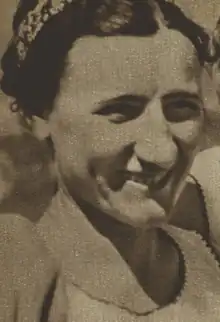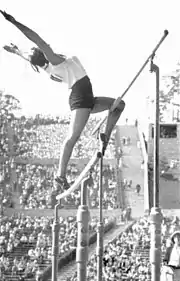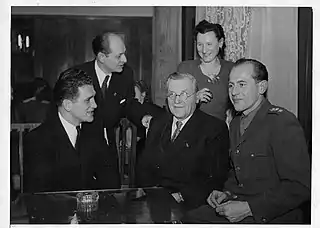Vlasta Děkanová
Vlasta Děkanová (5 September 1909 – 16 October 1974) was a Czechoslovak artistic gymnast. She was the first World all-around champion in women's artistic gymnastics.
| Vlasta Děkanová | |||||||||||||||||||||||||||
|---|---|---|---|---|---|---|---|---|---|---|---|---|---|---|---|---|---|---|---|---|---|---|---|---|---|---|---|
 Vlasta Děkanová in 1938 | |||||||||||||||||||||||||||
| Personal information | |||||||||||||||||||||||||||
| Country represented | |||||||||||||||||||||||||||
| Born | 5 September 1909 Prague, Austria-Hungary | ||||||||||||||||||||||||||
| Died | 16 October 1974 (aged 65) Prague, Czechoslovakia | ||||||||||||||||||||||||||
| Hometown | Prague | ||||||||||||||||||||||||||
| Residence | Prague | ||||||||||||||||||||||||||
| Discipline | Women's artistic gymnastics | ||||||||||||||||||||||||||
Medal record
| |||||||||||||||||||||||||||
Early life
Děkanová was born in Prague in 1909. Her father was a dedicated member of Sokol and the manager of a gym in the Žižkov district of Prague.[3]
She progressed through the Sokol system, graduating in 1933.[4] She performed locally at the Lucerna Palace. Beginning in 1928, Děkanová started touring and performing in exhibitions internationally in countries including Belgium, France, Netherlands, Poland, and Yugoslavia. In the United States, she performed in exhibitions in Cleveland, New York, and Washington.[3]
Competitive career

Děkanová made her World Championship competitive debut at the very first 1934 World Artistic Gymnastics Championships for women held June 11 and 12 that year in Budapest, Hungary. Reportedly, cheating in the scoring was uncovered and corrected, allowing the Czechoslovakian team, of which she was a part, to win the team title.[3] There was no individual competition. But when all of the individual totals were added up, Děkanová had the highest overall total.
Two years later, Děkanová competed at the next installment of the 1938 World Artistic Gymnastics Championships where she again was the highest individual finisher among all competitors, successfully defending her placement at the previous World Championships.
According to an official document published by the FIG, Dekanova "won the general competition at the 1934 and 1938 World Championships."[5]
)_Slet_in_1938.jpeg.webp)
Another supporting piece of information suggesting Děkanová's consistent excellence is that at a Czechoslovakian selection competition held on 15 May 1938, just weeks before the 1938 Worlds held on June 30 and July 1, Děkanová placed 1st among all 19 individuals.[6]
1936 Berlin Summer Olympics
Heading into the 1936 Berlin Summer Olympics as reigning World All-Around Champion (and eventual successful defender of her world all-around title at the next World Championships in 1938), Dekanova was a favorite to do extremely well and contribute heavily towards her team’s overall score and placement in the team standings. However, her excellent and consistent placement at the standing world championships and other competitions met with a considerable reversal of fortune at these games. Although there was no individual all-around competition for the women, individual standings were, nevertheless, tabulated in the official Olympic report. While placing near the top in the competitive field of 64 total individual contestants on both the uneven bars (8th place) and vault (5th place)[7] apparatuses with scores that were consistently relatively very good on both the compulsory and voluntary exercises, the only one of her six apparatus performances (including both compulsory and voluntary exercises on each apparatus) in the entire competition that was in the top 3 and reflective of her international champion status was her compulsory exercise on vault which was given the 3rd-highest mark for that exercise in the competition. On balance beam, in particular, her reversal of fortune was most revealing as she placed 22nd[7]: 870 with both her compulsory and voluntary exercises being given marks that were each well outside of the top 10. In summary, at the Olympics, Dekanova lost her 1st-place finish, which she successfully defended at the next World Championships, by dropping from 1st to 6th place, and her Czechoslovakian team was unsuccessful in defending their World Team Champions reputation, taking 2nd place to the home German team.[7]: 871
The reversal of fortune of Dekanova’s previous and further consistent champion status at these games headlines the much more extreme reversal of fortune experienced by both of the other then-current women’s world all-around medalists – Hungary’s Margit Kalocsai and Poland’s Janina Skirlińska who were, respectively, the 2nd and 3rd place finishers (out of a competitive field of 40 contestants) at the 1934 World Championships.[8] Kalocsai‘s and Skirlińska’s extreme reversals of fortune paralleled, with immediately adjacent juxtapositioning, each other’s, with score placements that nearly universally were far from being aligned with their other international competitive standings – whereas Kalocsai finished immediately above Skirlinska at the 1934 World Championships (2nd, to Skirlinska’s 3rd), she finished immediately below Skirlińska (41st, to Skirlińska’s 40th)[7]: 871 at these 1936 Berlin Summer Olympics. With the exception of Kalocsai’s marks on balance beam, where her combined compulsory and voluntary scores gave her an overall score of 5th[7]: 871 on that apparatus, all of both Kalocsai’s and Skirlinska’s marks in both the compulsory and voluntary exercises on each apparatus (Kalocsai was 61st on parallel bars, 33rd on vault, and, again, 5th on balance beam, whereas Skirlinska was 48th on parallel bars, 36th on vault, and 15th on balance beam)[7]: 870–871 were far from being at the top of the competitive field. (Two years later, whereas Kalocsai lacked the opportunity to re-assert her high ranking at the world championships due to Hungary not sending a team, Skirlinska re-asserted her competitive excellence at the next world championships in 1938 where, in the all-around individual standings, she was the 4th-place finisher (out of a field of 32 competitors), the highest-finishing non-Czechoslovakian female competitor at those championships in Prague, Czechoslovakia.)[9]

Additionally, the reversal of fortune of many of the top gymnasts in the world at these games was not limited to the reversals of fortune of Dekanova and her fellow 1934 world all-around medalists Kalocsai and Skirlinska. Their reversals of fortune were mirrored on the men’s side in the individual all-around competition, as well, again quite extremely in numerous instances, by several individual individuals who either already were or would become World or Olympic all-around champions or medalists that decade:
- 1924 Olympic All-Around Champion[8] from Yugoslavia, Leon Štukelj (also Bronze All-Around Medalist at the 1928 Olympics,[8]: 46 and 10th-place finisher at the 1931 Worlds[10]) finished in 32nd place here. [7]: 861
- 1930 World All-Around Champion[8] : 64 from Yugoslavia, Josip Primožič (also 5th-place finisher at the 1928 Olympics,[11] and 9th-place finisher at the 1931 Worlds[10]) finished in 31st place here. [7]: 861
- 1932 Olympic All-Around Bronze Medalist[8] : 46 from Finland, Heikki Savolainen (also 1st-place finisher at the 1931 Worlds[10] and 5th-place finisher at the 1934 Worlds[12]) – finished in 9th place here.[7]: 859
- 1938 World All-Around Champion[8]: 65 from Czechoslovakia, Jan Gajdoš (also 3rd-place finisher at the 1931 Worlds[10]) finished in 27th place here. [7]: 859
- 1934 World All-Around Bronze Medalist[8] : 64 from Czechoslovakia, Emanuel Löffler – (also 10th-place finisher at the 1928 Olympics[11] and 9th-place finisher at the 1938 Worlds[13]) finished in 40th place here,[7]: 859 which, coincidentally, was exactly the same dramatic reversal of fortune that Poland’s Janina Skirlińska experienced at these games as, like Loffler, she was also both 3rd-place finisher at the 1934 Worlds and 40th-place finisher at the 1936 Olympics (as referenced previously).
- 1932 Olympic All-Around Silver Medalist[8] : 46 from Hungary, István Pelle (also 7th-place finisher at the 1931 Worlds[10]) finished in 18th place here.[7]: 861
- Lastly and, by far, most dramatically, reigning 1932 Olympic All-Around Champion[8] : 46 from Italy, Romeo Neri (also 4th-place finisher at the 1928 Olympics,[11] 5th-place finisher at the 1931 Worlds,[10] and 2nd-place finisher at the 1934 Worlds[8]: 64 ), not even close to finishing the competition, and with scores that were consistently near the bottom of all of the competitors in the field, finished in dead last place – 111th.[7]: 861
In summary, Dekanova was far from alone in being the only world or Olympic all-around champion or medalist who experienced a reversal in fortune, some of them being quite extreme, in their competitive endeavors. She was joined in this experience by no fewer than 9 other gymnasts from no fewer than 6 different countries, including 2 different Olympic all-around champions and 2 different World All-Around Champions: Dekanova’s fellow Czechoslovakians Jan Gajdoš and Emanuel Löffler, Finland’s Heikko Savolainen, Hungary’s Margit Kalocsai and István Pelle, Italy’s Romeo Neri, Poland’s Janina Skirlińska, and Yugoslavia’s Josip Primožič and Leon Štukelj.
World War II Activities and Post-Competitive Career
Like many other Sokol members (gymnasts or otherwise) such as 1922 World All-Around Champion František Pecháček, 1928 Olympic Parallel Bars Champion Ladislav Vácha, and 1938 World All-Around Champion Jan Gajdoš, all also Czechoslovakian, and all of whom lost their lives as resistance fighters during World War II, Děkanová was also involved in the underground Czechoslovakian resistance in World War II. She was a magistrate and was involved in copying and distributing material from illegal publications, such as "V boj" ("Into combat") by prominent journalist Irena Bernášková. She was punished for such activities, once spending several weeks in jail.[3] She also served as a volunteer nurse during the Prague uprising of May 1945 and helped remove wounded soldiers from the front line of combat.[14]
After World War II, she remained active in the sport and trained young gymnasts. She was also involved in developing and maintaining city infrastructure as a planner and dispatcher of road and water management buildings.[3]

Legacy
Before the introduction of the women's full program at the 1952 Helsinki Olympics, medals were awarded to women's teams only, without distinguishing individual athletes. Therefore, Děkanová was the most decorated female artistic gymnast at the World and Olympic level, overall, in the era before World War II, taking into account what information is publicly available.
Additionally, as Děkanová led her team to its first two World Championship victories and coached her team to Olympic victory in 1948, she can be credited as playing a very crucial role in establishing the legacy of her country in the sport of women's gymnastics. At the 15 World and Olympic competitions held, from 1934 to 1970, they won team medals at all but 2 of those competitions, and one of their only two non-medal-wins was due to not attending, therefore, they won team medals at 13 out of their 14 showings at those various championships throughout that era.
References
- https://usagym.org/PDFs/Results/worlds_artistic_results_1934.pdf
- https://usagym.org/PDFs/Results/worlds_artistic_results_1938.pdf
- Uhrová, Eva (2010). "Stříbrná zlatá Vlasta Děkanová - Mistryně světa v tělocviku" [Silver Gold Vlasta Deanová - World Champion in Gym]. Krásná paní (in Czech). Retrieved 25 November 2020.
- "Upomínkový diplom pro Vlastu Děkanovou" [Commemorative diploma for Vlasta Dekanova]. eSbírky (in Czech). Národní Museum. Retrieved 25 November 2020.
- Huguenin, Andre. 110e Anniversaire: Objectif An 2000 (PDF) (in French, German, and English). International GYmnastics Federation. p. 115.
- Dusek, Peter Paul Jr. (1981). Marie Provaznik: Her Life and Contributions to Physical Education. University of Utah. p. 360.
- Organizing Committee for the 11th Berlin Olympiad. "The XIth Olympic Games Berlin, 1936 Official Report (Volume II)". pp. 870–871. Retrieved 2 May 2023.
- The Story Goes On: 125 Ans/Years Federation Internationale Gymnastique 1881-2006 (PDF) (in French and English). International Gymnastics Federation. p. 65.
- Macanovic, Hrvoje (30 July 1938). "Setsko gimnasticko prvenstvo 1938 u Pragu" [World Gymnastics Championships 1938 in Prague.]. Sokolsky Glasnik (in Slovenian). Vol. 9, no. 26–29. p. 34. Retrieved 2 May 2023.
- "Francuski prikaz o poslednjim pariškim gimnastičkim iakmičenjima za sveisko prvenstvo" [A French account of the last Parisian gymnastic competitions for all championship.]. Sokolsky Glasnik (in Slovenian). Vol. 2, no. 30. 23 July 1931. p. 1-2. Retrieved 13 January 2021.
- Netherlands Olympic Committee. van Rossem, G. (ed.). The Ninth Olympiad Being the Official Report of the Olympic Games of 1928 Celebrated at Amsterdam. Translated by Fleming, Sydney W. Amsterdam: J. H. Debussy Ltd. p. 668.
- Macanovic, Hrvoje (8 June 1934). "X medunarodne gimnastičke utakmice u Budimpešti" [X International Gymnastics Matches in Budapest.]. Sokolsky Glasnik (in Slovenian). Vol. 5, no. 24. p. 6. Retrieved 13 January 2021.
- Macanovic, Hrvoje (30 July 1938). "Setsko gimnasticko prvenstvo 1938 u Pragu" [World Gymnastics Championships 1938 in Prague.]. Sokolsky Glasnik (in Slovenian). Vol. 9, no. 26–29. p. 34. Retrieved 2 May 2023.
- "Potvrzení o účasti v Pražském povstání" [Confirmation of participation in the Czech Uprising]. eSbírky (in Czech). National Museum. Retrieved 25 November 2020.